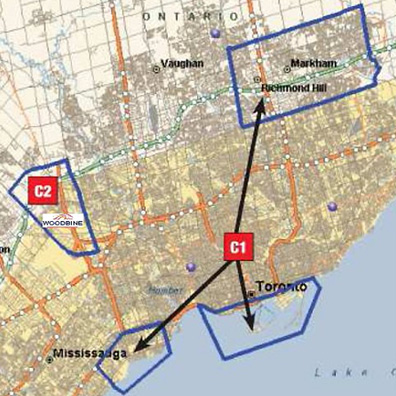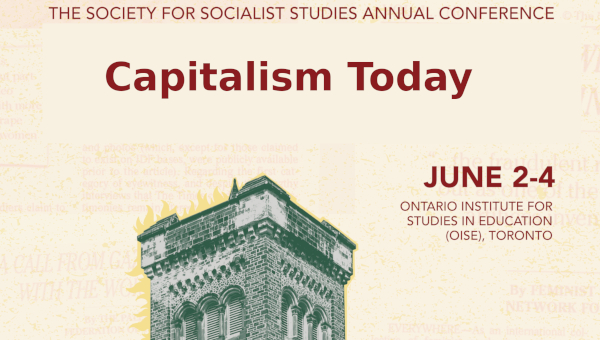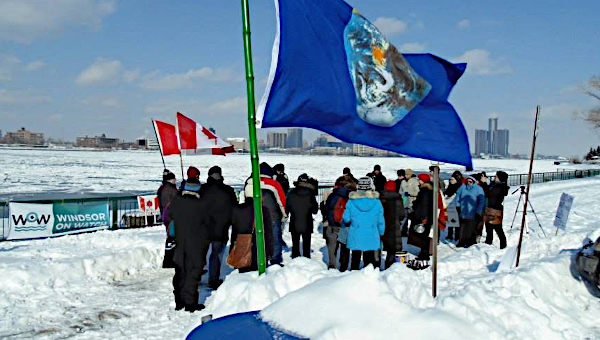On November 5, 2012 the Executive Committee of Toronto’s City Council voted to move ahead with public consultations on the benefits and location of a casino in the city. The marathon session included over 52 listed deputations from unions, social service professionals, boosters, and anti-casino residents. Unofficially, the meeting kicked off a four month public battle among the state, casino and real estate developers, and anti-casino forces. Toronto is no stranger to legal gambling or, to use the current vernacular, ‘gaming’ politics. In a 1997 referendum held just prior to amalgamation, the old city and the boroughs soundly rejected the idea of a casino in the city. Pre-amalgamation Toronto voted 70.6 per cent against the idea.
 The referendum was held in the midst of the 1990s casino craze when a New Democratic Party (NDP) government in Ontario, facing recession and record deficits, established a number of charitable and government owned casinos in border towns and others in cooperation with First Nations. Almost two decades later, multinational ‘gaming’ corporations and similarly deficit-challenged Liberal provincial government (now greatly addicted to gambling revenues) have targeted the lucrative Toronto market as a means of ‘modernizing’ gambling in Ontario. The ground has, however, shifted radically for anti-casino activists over the last 15 years. The rise of on-line gambling, the poker craze of the last decade, the first generation of Ontario casinos, the emergence of powerful multinationals, as well as government addiction to revenues have worked together to ‘normalize’ the industry.
The referendum was held in the midst of the 1990s casino craze when a New Democratic Party (NDP) government in Ontario, facing recession and record deficits, established a number of charitable and government owned casinos in border towns and others in cooperation with First Nations. Almost two decades later, multinational ‘gaming’ corporations and similarly deficit-challenged Liberal provincial government (now greatly addicted to gambling revenues) have targeted the lucrative Toronto market as a means of ‘modernizing’ gambling in Ontario. The ground has, however, shifted radically for anti-casino activists over the last 15 years. The rise of on-line gambling, the poker craze of the last decade, the first generation of Ontario casinos, the emergence of powerful multinationals, as well as government addiction to revenues have worked together to ‘normalize’ the industry.
Aside from the new realities, there are other challenges for anti-casino groups. There are complex questions any coordinated resistance to a new casino must first address. Is prohibition against gambling the only consistent position for a broadly defined Left? Are local anti-gambling campaigns limited by their not-in-my-back-yard (‘nimby’) approach to mobilizing popular support? What are the dangers of cross-class alliances between anti-casino capital, workers and community groups? What types of coalitions are necessary to defeat casino capital allied with the state? And finally, is it necessary to develop an exit strategy able to shift anti-casino campaigns to the fight for ‘responsible’ (i.e., unionized and well-regulated) casinos when development appears inevitable?
All of these questions require an analysis of the historical and geographical political economy of casino development in Ontario. More important, deep strategic thinking must occur in order to avoid further division over the issue within an increasingly pessimistic and disorganized working-class.
Casino States
A first step is to situate casino development in Toronto in a broader context that sees gambling as both an economic response to austerity and an industry that, for the most part, follows the capitalist logic of maximizing rents. The peculiarity of the industry derives not so much from its economics as it does from its relationship to real estate development and its regulation by governments increasingly addicted to revenues. The context has been well documented by Jim Cosgrave and Tom Klassen in their edited collection Casino State (2009).
Governments have promoted casinos in most cases as a form of export lead development in times of crisis. Alberta and British Columbia were the first to develop casinos in the 1980s, inspiring expansion of casinos throughout Canada. The early 1990s recession lead the Ontario government to develop First Nations, charitable and government owned casinos. Currently, there are 10 casinos in Ontario and another 17 ‘racinos’ which combine horse racing with slots facilities. On policy paper, casinos are meant to enhance tourism and attract visitors and the role of local residents as gamblers is downplayed. In Ontario, this had a geographical logic as the first round of state regulated casino development was largely in border communities (e.g., Thunder Bay, Sault Ste Marie, Windsor, Point Edward, Niagara Falls, and Gananoque).
Casinos fail as tourist attractions on many fronts. They are often small and non-descript, vulnerable to swings in the exchange rate, and the laws of competition simply lead bordering states to expand their own stock of casinos just a few kilometres south. As Ontario casinos approach twenty-years of age, and the limited local markets of problem and non-problem gamblers decline over time, there is no incentive for private or public reinvestment in situ and new larger markets are explored.
Casino development in Ontario is, perhaps, more accurately described as an import substitution strategy. Residents experience gambling in Las Vegas or Atlantic City and bring back ‘demand’ for gambling which can easily be met at home rather than abroad. The unique aspect of this type of import substitution is that the public has demanded that it be regulated. As a result, pseudo-monopolies can be granted to specific geographic areas and providers. ‘Racinos,’ for example, emerged in the late 1990s as a state strategy to finance the replacement of aging racetracks in the province and subsidize the largely rural horseracing industry. It is an example of how gambling monopolies are used to subsidize related industries and leverage development. In 2012, Ontario Lottery and Gaming Corporation (OLG) announced that it was ending the Slots at Racetracks Program as it was shifting to a more ‘customer driven’ model that would shift slots to more densely populated locations. Almost immediately the Ontario Horse Racing Industry Association and some unions representing workers in the racetracks initiated an aggressive campaign against the decision to end the profit sharing program between racetracks and the state. Claims went as far as stating the end of the program would mean 13,000 horses would have to be destroyed in Ontario.
Toronto is the last major metropolitan centre to escape full casino development. Casino Montreal was established in 1993 and Edgewater Casino in Vancouver opened in 2005. It is important to note, however, that Toronto’s Woodbine Racetrack has 3000 slot machines as part of the above profit sharing program. Woodbine Entertainment Group has been calling for a full casino at the site for some time, while others have advocated for a downtown location. For much of the 1990s and early 2000s, the future of Toronto’s waterfront was tied to the success of mega-events. However, the failure of Toronto to win the 1996 and 2008 Olympic Games has forced local elites to consider alternatives along the waterfront into the Port Lands. The Pan Am Games are not as ambitious and any bid for the World’s Fair or future Olympics is a generation away. The Ontario government’s decision to close Ontario Place as an attraction (perhaps in preparation for something ‘new’) also increases the pressure for rejuvenation.
Toronto and the ‘Modernization’ of Gambling
The decision to shift gambling policy in Ontario toward ‘customer driven’ geographic and service requirements was part of a ‘modernization’ exercise undertaken by OLG in 2010. The 30 page report, Modernizing Lottery and Gaming in Ontario, was released in 2012 and contained three recommendations to government: 1) become more customer-focused; 2) expand regulated private sector delivery of lottery and gaming; and 3) renew OLG’s role in oversight of lottery and gaming.
The implications for casino development are made quite explicit throughout the report. First, ‘customer-focused’ means that gaming will move toward densely populated markets to increase access and create new gamblers. This is not only restricted to the relocation and building of new casinos, but also the establishment of an on-line gaming presence in people’s homes. Any geographical prioritization given to rural areas or de-industrialized border cities is repealed as the industry seeks rent maximizing locations. Market forces will now decide casino sites. Second, the expansion of the ‘regulated private sector’ means that multinational casino corporations will be encouraged to expand their role in casino development and operations. Given that Canada’s gambling industry is relatively young, this means that firms with anchor properties in Las Vegas and Atlantic City will be the frontrunners in any competitive process. Third, the ‘renewal’ of OLG’s oversight role is a concession to a public that wants corruption free lotteries, any expanded private sector involvement in gambling to be free of organized crime, and a state commitment to containing the social costs of gambling addiction.
The OLG report was initiated in the midst of the current economic crisis and its release occurs as the government searches for sources of revenue other than increased taxation. The report stresses the importance of the Greater Toronto Area (GTA) where “customer interest is not being met.” For the province, a mega-casino in the largest market is crucial to meeting current and generating future demand. For the city, even more is at stake. Casino development is integrated into larger real estate development initiatives. In order to ‘win’ a waterfront casino, private developers must integrate renewed public infrastructure, commercial and residential investment into the project. At a time when capital is committed to hoarding investment, leveraging billions of dollars in new public space, buildings, hotels attached to casinos is attractive for many local boosters.
 Several options for casino development have been proposed which are consistent with the gaming zones indentified by the OLG. Of the 29 zones identified in the modernization report, two (C1 and C2) are in the Toronto. C1 has three sub areas, the waterfront, Mississauga, and an area including Markham and Richmond Hill. C2 is another large zone covering the area west of Highway 27 from Dixon Road into Malton, conveniently capturing the Woodbine Racetrack. On October 22, the City Manager reported findings from consultants Ernst and Young that an integrated casino and entertainment project in C1 would generate up 4600 construction related jobs and up to 5,100 net new jobs. New revenues for the city in terms of ‘hosting fees’ were estimated to reach up to $168-million, before any government lease or sale of land. The size of the mega-casino necessary to generate these funds, 300,000 square feet, is 1.5 times larger than Fallsview Casino in Niagara Falls and Casino Rama in Orillia.
Several options for casino development have been proposed which are consistent with the gaming zones indentified by the OLG. Of the 29 zones identified in the modernization report, two (C1 and C2) are in the Toronto. C1 has three sub areas, the waterfront, Mississauga, and an area including Markham and Richmond Hill. C2 is another large zone covering the area west of Highway 27 from Dixon Road into Malton, conveniently capturing the Woodbine Racetrack. On October 22, the City Manager reported findings from consultants Ernst and Young that an integrated casino and entertainment project in C1 would generate up 4600 construction related jobs and up to 5,100 net new jobs. New revenues for the city in terms of ‘hosting fees’ were estimated to reach up to $168-million, before any government lease or sale of land. The size of the mega-casino necessary to generate these funds, 300,000 square feet, is 1.5 times larger than Fallsview Casino in Niagara Falls and Casino Rama in Orillia.
Registered lobbyists with proposals for almost all these areas are currently ‘occupying’ Toronto’s city hall. The three major locations for consideration are all located along Toronto’s waterfront. Least developed are plans to include casino development as part of the Port Lands Acceleration Initiative, set in motion after Doug Ford’s 2011 failed proposal for giant ferris wheel and monorail on the brownfield site. Jerry Sprackman, a local real estate owner in the area, has called for a large integrated casino resort in the area as well as a temporary casino during construction. The brownfield location does have the required space for the 5000 to 7000 parking spots, and it is argued the casino would anchor development necessary to secure the floodplain at the mouth of the Don River and allow further redevelopment across the eastern waterfront to Leslie Street.
A more developed proposal has been focused on Ontario Place which was closed in 2012. Exhibition Place which currently hosts a casino in August each year during the Canadian National Exhibition (CNE) is preferred by Rob Ford as it is city owned land. But Brian Ashton, President of the CNE Association, has stated in a letter to the Executive Committee that such a project would have ‘serious implications’ for the CNE. John Tory was appointed by the province to an advisory panel on the long-term redevelopment of Ontario Place. MGM Resorts has proposed a large integrated resort development for the provincially owned site based on a large casino. The Port Lands, Exhibition Place and Ontario Place are all state owned which would give governments an opportunity to sell or lease the land to developers. In the case of Ontario Place, its provincial ownership makes it much more zoning friendly.
The proposal receiving the most attention at the moment is an expansion of the Metro Toronto Convention Centre (MTCC), privately owned by Oxford Properties, the real estate arm of the Ontario Municipal Employees Retirement System (OMERS). Oxford is developing a proposal with Caeser’s Entertainment Corporation for a $3-billion dollar casino and real estate project around the MTCC. Unlike the other waterfront proposals, the land is held privately held.
There are also a number of rival interests seeking to develop a casino outside of the downtown core. As mentioned above, Woodbine Entertainment Group has taken out advertisements claiming a waterfront casino would reduce slots revenue and harm its facility. Indeed, the $1-billion proposed development Woodbine Live! financed with $120-million in local tax credits has yet to emerge as the financial crisis delayed the project that many were convinced hinged on a casino in any case. Downsview Park is another potential site within the city limits. ONEX Corp has hired Kyle Rae to lobby against downtown casino development in favour of a suburban casino project, most likely in Mississauga.
The OLG, the provincial government and pro-casino councillors all prefer a downtown casino. Aesthetics, higher population density, central transportation facilities, and parking (especially in the case of the Ontario and Exhibition Place lots) are most often cited. Together these create higher location rents along the waterfront. As casino operators are able profit more from a waterfront location, the competitive local state is able to leverage a much larger integrated project attached to a casino and higher hosting fees than the case of a suburban casino. This is perhaps the biggest contradiction facing anti-casino activists. If casino development is stopped downtown, but successfully retreats to other locations in the Greater Toronto Area, the demands the state can make on casino investors will be modest.
The Particular Case of ‘No Casino Toronto’
Resistance to a downtown casino has mobilized. Left councillors, Paula Fletcher, Adam Vaughn, Mike Layton and Mary Fragedakis have all spoken vehemently against casinos in or near their wards. A small community group started by three women from Etobicoke, No Casino Toronto, has assisted with the organization of preliminary community meetings. Any resistance will be challenged to turn back all the powerful proposals backed by the state and multinational casino capital. A great deal is at stake, as an integrated waterfront casino project may be the most significant change in Toronto’s built environment outside of transit expansion. Unfortunately, there are limitations to the early stages of the campaign.
First, the campaign is largely embedded in a ‘not-in-my-back yard’ framework. Rhetorically, No Casino Toronto, is calling for an outright prohibition and asks people to ‘stand up for your city,’ but it is largely a downtown focussed group. One of the group’s first community panels organized with Councillors Fletcher and Fragedakis as well as MPP Peter Tabuns was organized around ‘No Casino in the Port Lands.’ There appears to be less concern over a casino in Etobicoke, and given the name of the anti-casino group, no strategy to fight a casino in Mississauga. At best, the campaign is vulnerable to charges of elitist ‘nimbyism,’ protecting the waterfront for other ‘high road’ development uses. At worst, it can appear collaborationist with forces seeking to protect and develop gambling assets elsewhere in the GTA.
Another challenge facing the current ‘no casino’ struggle is its ‘prohibitionist’ narrative. At the No Casino in the Port Lands meeting, Nigel Turner, from the Centre for Addiction and Mental Health (CAMH), provided a succinct overview of the perils of gambling as a health issue. There is strong evidence documenting to social problems of gambling addiction, reported by CAMH as affecting 3 per cent of the population. However, there is a danger of a paternalistic narrative that emphasizes casinos as a ‘social ill,’ ‘tax on the poor,’ or ‘vice.’ The working-class is disciplined by capital productive relations and regulating their consumptive bodies in processes of accumulation is always resisted. The controlled distribution of alcohol and prohibition against marijuana continue to be resisted by workers (especially, young future workers). The working-class is fully aware that gambling addiction is a very real social problem. But there are limits to mobilization strategies that tell people how they should not spend their wages. This is especially hypocritical when their savings and pension funds (if they are fortunate enough to have them) are gambled by others in the global financial casino on a daily basis, as succinctly articulated in the above quotation by Engels.
Organized labour’s response to the proposals is a textbook case of local particularist politics. Construction unions and hospitality workers’ unions such as UNITEHERE Local 75 are supporting casino development. Liz Pimental, President of Local 75, has deputed that support in contingent upon unionization of casino workers, a fair revenue share for government, improvements in public infrastructure, local hiring, and ‘green’ building design. The CAW, representing workers at Woodbine, are advocating restricted development of new casinos in Ontario and for a racetrack casino. Local 2 SEIU President, Cameron Nelson, also representing workers at Woodbine and eager to represent the new casino, has proposed two casinos be built in Toronto, one at the racetrack site and another downtown as a “true opportunity for positive growth and revitalization in our city.” Public sector unions such as CUPE have not yet issued any strong statement for and against casino development. Public workers in addiction services would definitely face workplace pressures with increased gambling in the city, but increased revenues may alleviate some austerity pressures. CUPE also represents casino workers in Alberta.
What is lacking is leadership that can transcend the particular interests of different unions. The Toronto and York Region Labour Council has not issued a public statement for or against the casino, and will likely remain neutral given the potentially divisive issue. There is no effort to negotiate a comprehensive position on gambling from organized labour at the municipal, provincial, or federal levels.
Labour and community groups have also failed to put forth a coherent alternative vision for the waterfront that challenges not only casino development but the official vision of Waterfront Toronto, the agency created by all three levels of government to guide waterfront revitalization. Waterfront Toronto has officially opposed development of a casino in the Port Lands, but has remained silent about the other sites. The agency’s vision is for a 25 year gradual development of mixed land uses along city’s ‘blue edge.’ Green space with residential and commercial uses is goal with emphasis on knowledge economy industries.
The vision is very much in keeping the policies advocated by Toronto boosters such as Richard Florida who has vehemently opposed the development of a casino along the waterfront. Kevin Stolarick, Research Director of the Martin Prosperity Institute, and colleague of Florida’s, has also been very vocal in his opposition to a casino speaking to community and business groups and deputing against the development. Florida and Stolarick’s position is consistent with their view of a creative city rich with amenities necessary to attract knowledge workers. Highly securitized casinos and low-brow retail are not part of this vision, but public green spaces are. The creative class vision is far from an alternative to competitive capitalism. But it does represent a rupture among Toronto elites as to the direction of economic development in stark contrast to the casino, ferris wheel and monorail vision of the Fords. For Florida, the casino issue is one where there is significant consensus among urbanists and planners, but this is not necessarily true for the public at large.
Any campaign must confront the limits of simply advocating for a ‘high road’ model of economic development. The knowledge economy is exclusionary, requiring specific skills and training many workers do not have or are not recognized for workers trained outside Canada. Many in working-class communities do gamble, and many others will take any a job a casino provides. It should not be surprising that parts of Toronto’s working-class will embrace the Ford’s version of economic development, especially when the alternative presented simply benefits another segment of the capitalist class.
Perhaps the most troubling aspect of the early opposition is that there is no exit strategy if the political and economic forces driving a casino on the waterfront or elsewhere are successful. At what point does a ‘No Casino’ movement become a ‘Responsible Casino’ movement? Again, the consequences of not having a back-up plan to prohibition could be devastating. Not only will a community group be defeated, but more aggressive and reactionary casino corporations may enter Toronto with no restrictions on their behaviour. The Las Vegas Sands Corporation based in Nevada has also expressed interests in a casino in the GTA. The Sands is owned by Republican supporter Sheldon Adelson, known for running one of the few large non-union properties in Las Vegas, an expansion into Macau’s gambling sector, and more recently for his entry into the Israeli newspaper market. For many, a casino developed by Adelson would be the worst case scenario.
There is, however, a strong anti-casino sentiment in Toronto. Many of the speakers at the Executive Committee meeting were No Casino activists. Many spoke passionately against the recommendation to begin a public consultation process based on the consultants’ report.
Community Alliance Building
As the consultation process goes forward anti-casino forces will have mobilize and pressure the OLG to keep its commitment to not force any unwanted casino onto a community. First and foremost, a broad coalition beyond three committed activists from Etobicoke must be formed. Coalition politics that bring a number of community, religious, and labour groups together in an alliance is necessary to convince councillors and MPPs that there will be a political cost to letting a casino develop in Toronto. The coalition must also extend beyond the city of Toronto into the GTA to block development in the suburbs. A non-partisan alliance organized along the model of CitizensUK (www.citizensuk.org) and its local chapters under London Citizens might prove most effective. London Citizens successfully fought for a London living wage rate and has continued to actively campaign for sanctuary for undocumented people, affordable housing, safe communities and good jobs. Experiments with the alliance model are currently taking place in Vancouver and Sydney. A broad coalition may have some success against casino development and present an opportunity to build community capacity for future anti-austerity struggles.
Second, the prohibitionist narrative must be shifted to broader questions about what actually constitutes sustainable urban development. The social costs of increased problem gambling are not to be underestimated, but paternalism can be a barrier to public mobilization. What is clear is that the economic benefits of casino development always underperform or even disappear in most cases. Successful casino development in a tourist city such as Las Vegas is a specific exception with its own set of problems and contradictions.
Third, if community alliances need to confront NIMBYism, then local labour in Toronto must confront its crude particularist politics. It is naive to expect construction workers to speak against a $3-billion project or hotel workers representing 50,000 workers in Nevada to speak against casinos. It is not, however, unreasonable to demand that such vested unions develop a coherent sector strategy advocating for tourism and casino development that is responsible and recognizes that the best location may not be only where they have a strong existing presence. Simply fighting to expand membership limits any gains to a militant particularism incapable of building working-class power. An alternative sector strategy that invests gambling capital in a tourist region (e.g. Niagara Falls) rather than concentrating more capital in Toronto might be a better strategy for Ontario. It would also pose an alternative to prohibitionist ‘high-road’ creative capital visions to which anti-casino forces are presently allied. Broader visions for waterfront development within capitalism are also needed, including the re-industrialization of the Port Lands around green production.
Lastly, any strategic campaign must have an exit strategy, perhaps the most difficult challenge. If a casino is to land in Toronto, the waterfront will be the location where the state is able to extract the most from developers. Less will be gained in Rexdale, Mississauga or Markham. If a casino does come to the GTA, the campaign must be able to shape its development even after opposing it. An anti-union casino employer shaping the city’s built environment as it pleases will be Toronto’s worst nightmare. •





